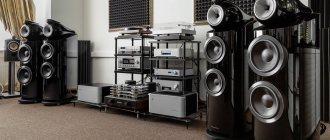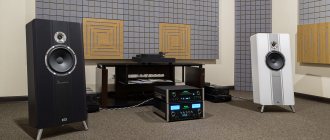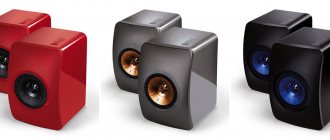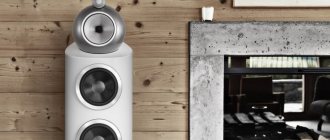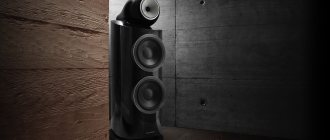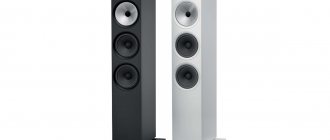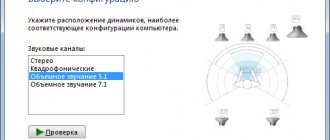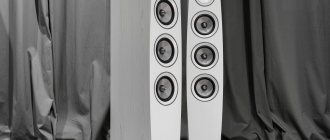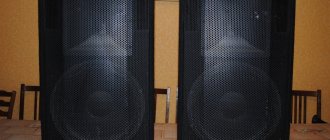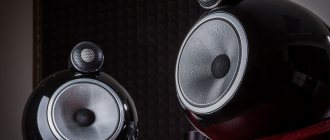It just so happens that the level of production of any brand is determined by the parameters of its flagship product. Although, it may be more logical to analyze entry-level products and see what the developer is capable of within the constrained confines of a modest budget.
However, I’ll leave this debate to the marketers. We have an excellent opportunity to analyze what exactly the authoritative English engineers from Bowers & Wilkins were able to offer lovers of high-quality audio in the flagship floorstanding speakers of their freshly updated 600 series, which is precisely at the entry level. The sixth iteration of the 600 Series, which has seen over a million owners over the years, is Bowers & Wilkins' longest-ever loudspeaker range in its class since its flagship 800 Diamond Series.
The updated six hundredth included (in order of seniority): floor-standing speaker 603, bookshelf speakers 606 and 607, as well as center channel speaker HTM6. In configurations that differ from the classic stereo, they are proposed to be supplemented with ASW610XP, ASW610 and ASW608 subwoofers, carried over from the previous 600-series set and given a new finish.
Let's start with an inspection
So, the B&W 603, the flagship floorstander of the new 600 series, is ready for inspection. By moving the bass reflex ports to the rear wall of the case, the speakers began to look stricter and more harmonious. They are proportional, but connoisseurs of B&W acoustics may miss the usual dominant design - the yellow Kevlar diffusers, which have become almost a trademark of the brand's acoustics.
Cabinet with and without grill - thoroughly and proportionately
Bowers & Wilkins worked a lot with Kevlar, and did it well. Now its place has been taken by Continuum technology, whose silver cones, according to the developers, provide accurate mid-range sound with even more detail than their Kevlar predecessors.
Continuum drivers were first used in the flagship 800 Series Diamond, including the 800 D3 models released in 2015. The appearance of Continuum in the 600 series makes one expect good results, especially since the mid-frequency range is perhaps the most critical from the point of view of fidelity.
Continuum driver is responsible for mid frequencies
If we evaluate the dimensions of the mid-frequency driver, comparable to the woofers located underneath, then the advantages of Continuum become clear, the rigidity of which made it possible, by increasing the area of the emitter, to reduce the stroke of the diffuser and thereby improve many reproduction parameters.
However, Kevlar is still present in B&W 603. It is used in the black diffusers of a pair of low-frequency drivers, which received a geometric Aerofoil profile. The recognizable yellow color is not visible, since the inner layer of the sandwich structure of the diffuser is made of Kevlar. The outside is orthodox black pulp, the musicality of which is still undeniable.
The midrange and tweeter are as close as possible
The low-frequency section works on a bass reflex located at the rear, and the creators of the new 600 series focus the attention of future owners on the practical independence of the sound of the low-frequency range from the notorious distance to the rear wall of the room. The bass reflex port with an output (nozzle) of smoothly varying curvature has the traditional proprietary Flowport surface. Small, regularly spaced indentations reduce flow turbulence in the same way as golf balls, neutralizing possible overtones.
The bass reflex is combined in a single massive plastic part with a panel of speaker cable terminals, which provide all connection options - both terminals and bananas, and disconnecting the jumpers will allow for a bandpass, bi-wiring or bi-amping connection with separate amplifiers for the low-frequency and high-frequency sections.
A pair of woofers creates a powerful combined effect
Threaded terminals with massive metal nuts look heavy and durable, allowing you to accept a fairly thick cable. Which is logical: the maximum power of the system is indicated on the rear panel - 200 W.
Characteristics of floor-standing acoustics B&W 603
| Number of lanes | 3 |
| Number of speakers | 4 |
| Type of shell | bass reflex, Flowport is located in the rear |
| Tweeter type | 25mm Decoupled Double Aluminum Dome Tweeter |
| Diameter and type of midrange driver | 160 mm, Continuum diffuser on FST suspension |
| Diameter and type of LF emitter | 2 x 165 mm (6.5”) bass drivers, Kevlar and paper cones |
| Frequency range | 29 Hz – 33 kHz (- 6 dB) |
| Frequency range | 48 Hz – 28 kHz (+/- 3 dB) |
| Sensitivity | 88.5 dB (2.83 V/1 m) |
| Harmonic distortion (2nd and 3rd harmonics, 90 dB, 1 m) | less than 1% (110 Hz – 22 kHz), less than 0.5% (180 Hz – 20 kHz) |
| Impedance | 8 ohms, minimum: 3 ohms |
| Recommended amplifier power | 30 – 200 W |
| Input Connectors | 2 pairs of screw terminals |
| Grill mount | magnetic |
| Dimensions (WxHxD) | 190 x 1055 x 320 mm |
| Weight | 24.1 kg |
Full set
The ability to adjust the sound of the 603s in the low frequency region is implemented simply and intelligently. The kit includes foam rubber plugs for the bass reflex. Moreover, it can be blocked in two ways - completely or partially, since each plug consists of two parts: a thick-walled pipe and a cylinder inserted into it. Using everything together, you can block the bass reflex almost tightly.
The high-frequency range is handled by B&W's patented "ultra-low distortion" Decoupled Double Dome aluminum tweeter, which they say can "reveal amazing levels of detail in your music." The tweeter is protected by an elegant silver grill with “triangular” weaving in a well-crafted aluminum frame.
Twitter design
The most interesting thing, as always, is hidden from view: the tweeter has a rear acoustic volume, often used in B&W models, in the form of a tube extended back along the axis. This part serves to further equalize the amplitude-frequency response in the high-frequency region and prevent the appearance of unwanted micro-resonances.
The tweeter in this version is supplemented with a neodymium magnet, borrowed from the older 700 series models. The stated upper frequency limit of sound is 38 kHz, and it is much higher than the average capabilities of human hearing, which was done in order to obtain a more natural sound in the high frequency range.
The outer surface of the woofer cone is classic cellulose
The B&W 603 cabinet has a sleek matte vinyl finish in black or white, which in any case looks good in combination with formal fabric grills. The texture of the grills has changed little in appearance: however, unlike the previous version, now they are no longer mounted on pins going into the bushings. The front walls of the case are free of these parts, which are replaced with invisible magnets. The grilles cover the entire front panel; for the black finish of the speaker cabinet they are made black, and for the white one they are made gray.
If we try to formulate as briefly as possible how the new B&W 603 externally differs from its predecessors, it is the absence of any fasteners on the visible surfaces of the cabinet. The speakers have a more seamless, minimalistic, precise and harmonious design.
The long stroke of the woofer diffuser is ensured by a flexible half-wave external suspension
The housings are mounted on screw supports, which are fixed directly to the bottom plane; the kit includes two options for supports: spikes and damping polyurethane hemispheres. The owner can choose them depending on the type of coating; by the way, mixed use of supports may also give an interesting result. Adjustment of the height of each support is provided in both cases, and the threaded posts are secured with locknuts.
Bowers & Wilkins 603 acoustics test
It just so happens that the level of production of any brand is determined by the parameters of its flagship product. Although, it may be more logical to analyze entry-level products and see what the developer is capable of within the constrained confines of a modest budget.
However, I’ll leave this debate to the marketers. We have an excellent opportunity to analyze what exactly the authoritative English engineers from Bowers & Wilkins were able to offer lovers of high-quality audio in the flagship floorstanding speakers of their freshly updated 600 series, which is precisely at the entry level. The sixth iteration of the 600 Series, which has seen over a million owners over the years, is Bowers & Wilkins' longest-ever loudspeaker range in its class since its flagship 800 Diamond Series.
The updated six hundredth included (in order of seniority): floor-standing speaker 603, bookshelf speakers 606 and 607, as well as center channel speaker HTM6. In configurations that differ from the classic stereo, they are proposed to be supplemented with ASW610XP, ASW610 and ASW608 subwoofers, carried over from the previous 600-series set and given a new finish.
Let's start with an inspection
So, the B&W 603, the flagship floorstander of the new 600 series, is ready for inspection. By moving the bass reflex ports to the rear wall of the case, the speakers began to look stricter and more harmonious. They are proportional, but connoisseurs of B&W acoustics may miss the usual dominant design - the yellow Kevlar diffusers, which have become almost a trademark of the brand's acoustics.
Bowers & Wilkins worked a lot with Kevlar, and did it well. Now its place has been taken by Continuum technology, whose silver cones, according to the developers, provide accurate mid-range sound with even more detail than their Kevlar predecessors.
Continuum drivers were first used in the flagship 800 Series Diamond, including the 800 D3 models released in 2015. The appearance of Continuum in the 600 series makes one expect good results, especially since the mid-frequency range is perhaps the most critical from the point of view of fidelity.
If we evaluate the dimensions of the mid-frequency driver, comparable to the woofers located underneath, then the advantages of Continuum become clear, the rigidity of which made it possible, by increasing the area of the emitter, to reduce the stroke of the diffuser and thereby improve many reproduction parameters.
However, Kevlar is still present in B&W 603. It is used in the black diffusers of a pair of low-frequency drivers, which received a geometric Aerofoil profile. The recognizable yellow color is not visible, since the inner layer of the sandwich structure of the diffuser is made of Kevlar. The outside is orthodox black pulp, the musicality of which is still undeniable.
The low-frequency section works on a bass reflex located at the rear, and the creators of the new 600 series focus the attention of future owners on the practical independence of the sound of the low-frequency range from the notorious distance to the rear wall of the room. The bass reflex port with an output (nozzle) of smoothly varying curvature has the traditional proprietary Flowport surface. Small, regularly spaced indentations reduce flow turbulence in the same way as golf balls, neutralizing possible overtones.
The bass reflex is combined in a single massive plastic part with a panel of speaker cable terminals, which provide all connection options - both terminals and bananas, and disconnecting the jumpers will allow for a bandpass, bi-wiring or bi-amping connection with separate amplifiers for the low-frequency and high-frequency sections.
Threaded terminals with massive metal nuts look heavy and durable, allowing you to accept a fairly thick cable. Which is logical: the maximum power of the system is indicated on the rear panel - 200 W.
Full set
The ability to adjust the sound of the 603s in the low frequency region is implemented simply and intelligently. The kit includes foam rubber plugs for the bass reflex. Moreover, it can be blocked in two ways - completely or partially, since each plug consists of two parts: a thick-walled pipe and a cylinder inserted into it. Using everything together, you can block the bass reflex almost tightly.
The high-frequency range is handled by B&W's patented "ultra-low distortion" Decoupled Double Dome aluminum tweeter, which they say can "reveal amazing levels of detail in your music." The tweeter is protected by an elegant silver grill with “triangular” weaving in a well-crafted aluminum frame.
The most interesting thing, as always, is hidden from view: the tweeter has a rear acoustic volume, often used in B&W models, in the form of a tube extended back along the axis. This part serves to further equalize the amplitude-frequency response in the high-frequency region and prevent the appearance of unwanted micro-resonances.
The tweeter in this version is supplemented with a neodymium magnet, borrowed from the older 700 series models. The stated upper frequency limit of sound is 38 kHz, and it is much higher than the average capabilities of human hearing, which was done in order to obtain a more natural sound in the high frequency range.
The B&W 603 cabinet has a sleek matte vinyl finish in black or white, which in any case looks good in combination with formal fabric grills. The texture of the grills has changed little in appearance: however, unlike the previous version, now they are no longer mounted on pins going into the bushings. The front walls of the case are free of these parts, which are replaced with invisible magnets. The grilles cover the entire front panel; for the black finish of the speaker cabinet they are made black, and for the white one they are made gray.
If we try to formulate as briefly as possible how the new B&W 603 externally differs from its predecessors, it is the absence of any fasteners on the visible surfaces of the cabinet. The speakers have a more seamless, minimalistic, precise and harmonious design.
The housings are mounted on screw supports, which are fixed directly to the bottom plane; the kit includes two options for supports: spikes and damping polyurethane hemispheres. The owner can choose them depending on the type of coating; by the way, mixed use of supports may also give an interesting result. Adjustment of the height of each support is provided in both cases, and the threaded posts are secured with locknuts.
Let's move on to listening
I was able to examine and touch all this while removing the speakers from the cardboard packaging - for listening I got completely new B&W 603. At the same time, the older bookshelf speakers of the new 600 series - B&W 606 - were already installed in the listening room.
The design of the two speakers is very similar - in fact, we can assume that to make the 606th, the lower part with the low-frequency speakers was “sawed off” from the body of the 603rd, and in place of the mid-frequency driver, a Continuum midrange/bass driver of almost the same caliber was installed, but with rubber external diffuser suspension. At the rear there is apparently the same bass reflex module, combined with the speaker cable terminal panel. It will be interesting to compare the sound of both systems, although the main goal is still the B&W 603.
The already collectible Oppo BDP 103D universal player was used as a signal source for listening. It was connected to a Classe Sigma 2200i amplifier.
The first impression is one of the most important. The eldest of the junior floorstanders from B&W surprised me. No “budget” discounts. Right out of the box, these acoustics produced truly large, full-size sound both in dynamics and in the frequency range - something for which, in fact, full-size floor-standing systems are needed. The 603s sounded broadly, clearly, powerfully, and emotionally.
But, I repeat, this was the first impression - now it’s a matter of details, in which, as we know, “the devil lurks.” And, if you listen carefully, this devil can be found in the freshly unpacked 603 - there is still some uncertainty in the mid-frequency range, forcing you to closely monitor possible artifacts at the border of the tweeter and midrench ranges.
To be honest, I couldn’t find fault for long. The devil rapidly decreased in size, turning into a small imp within about 15 minutes. Warming up was rapid, and it is obvious that after the first about five hours of operation of the 603s at the standard level of 80-85 dB (that is, quite loud), these speakers are definitely go “on the regime”. Further use, undoubtedly, makes this acoustics a source of growing positive emotions every time.
In any case, after half an hour the lazy Norah Jones in the composition “Wish I Could” allowed herself to position herself right in front of me, delighting with every nuance of phrasing and making me think about who wrote the “backings” - herself or the guest vocalist? The track, emasculated in terms of frequency full range, made it possible to appreciate how accurately and truthfully the speakers were able to convey the smallest shades of sound.
Benjamin Clementine in "London" was played accurately and with good speed, in the entire range of moods of this music - from light piano to the overall gloomy fortissimo symphonic composition. Moreover, I started listening to the beginning of the composition at excessive volume, but the climax did not force me to turn it down - the speakers powerfully “opened up” the stage and gave away almost everything that was recorded.
The very fast and full-range John McLaughlin on “El Hombre Que Sabia” sounded quite unrestricted and precise, with all the incredible percussion counterpoints and guitar passages. “Stimela (The Coal Train)” is perhaps the most revealing track for the 603s, allowing the acoustics to demonstrate how carefully the pattern of a lead instrument can be recreated against the backdrop of a powerful, all-consuming bass rhythm section.
At some point, I switched to the shelf 606 model and discovered, first of all, that very “sign of mastery” - the stability of the signature sound character, which is very impressive in thoroughbred acoustics. This is an absolutely equivalent sound, which is all the more surprising considering the completely different set of bass and midrange drivers in the 603 and 606 models.
The sound is almost identical, with the exception of a small “but” - the low-frequency range, naturally, turned out to be somewhat cut down. You can't fool physics. This feeling remained on the periphery of attention for the first 30 seconds after switching from 603 to 606, then it ceases to be noticeable, and “Chega de Saudade (No More Blues)” by Jobim (from Antonio Carlos Jobim “Jazz 'Round Midnight” ) made me think about the question of which of the two systems should be preferred.
conclusions
Let's go back to the 603s. For the “budget class” their capabilities undoubtedly leave a serious impression. If we talk about adjusting the sound, then “adjusting” in the case of them changes little. The “stereo sweet spot” of listening in this case turned out to be much larger than usual. But replacing the supports, using plugs in combination with changing the location may allow sound connoisseurs to discover the additional advantages of these systems.
The scene formed by this acoustics turns out to be almost completely “detached” from the sources, and it was also seriously refined during a short warm-up. The sound of the 603s is bright and tireless; its character does not have the “monitoriness” inherent in many similar systems, and it is pleasant to listen to them longer, discovering new nuances of seemingly well-known phonograms.
Based on materials from stereo.ru
Let's move on to listening
I was able to examine and touch all this while removing the speakers from the cardboard packaging - for listening I got completely new B&W 603. At the same time, the older bookshelf speakers of the new 600 series - B&W 606 - were already installed in the listening room.
The design of the two speakers is very similar - in fact, we can assume that to make the 606th, the lower part with the low-frequency speakers was “sawed off” from the body of the 603rd, and in place of the mid-frequency driver, a Continuum midrange/bass driver of almost the same caliber was installed, but with rubber external diffuser suspension. At the rear there is apparently the same bass reflex module, combined with the speaker cable terminal panel. It will be interesting to compare the sound of both systems, although the main goal is still the B&W 603.
Front view and rear view
The already collectible Oppo BDP 103D universal player was used as a signal source for listening. It was connected to a Classe Sigma 2200i amplifier.
The first impression is one of the most important. The eldest of the junior floorstanders from B&W surprised me. No “budget” discounts. Right out of the box, these acoustics produced truly large, full-size sound both in dynamics and in the frequency range - something for which, in fact, full-size floor-standing systems are needed. The 603s sounded broadly, clearly, powerfully, and emotionally.
Traditional for the brand, a single block of bass reflex and speaker cable terminals
But, I repeat, this was the first impression - now it’s a matter of details, in which, as we know, “the devil lurks.” And, if you listen carefully, this devil can be found in the freshly unpacked 603 - there is still some uncertainty in the mid-frequency range, forcing you to closely monitor possible artifacts at the border of the tweeter and midrench ranges.
To be honest, I couldn’t find fault for long. The devil rapidly decreased in size, turning into a small imp within about 15 minutes. Warming up was rapid, and it is obvious that after the first about five hours of operation of the 603s at the standard level of 80-85 dB (that is, quite loud), these speakers are definitely go “on the regime”. Further use, undoubtedly, makes this acoustics a source of growing positive emotions every time.
Standard set of supports - spikes and elastic hemispheres
In any case, after half an hour the lazy Norah Jones in the composition “Wish I Could” allowed herself to position herself right in front of me, delighting with every nuance of phrasing and making me think about who wrote the “backings” - herself or the guest vocalist? The track, emasculated in terms of frequency full range, made it possible to appreciate how accurately and truthfully the speakers were able to convey the smallest shades of sound.
Benjamin Clementine in "London" was played accurately and with good speed, in the entire range of moods of this music - from light piano to the overall gloomy fortissimo symphonic composition. Moreover, I started listening to the beginning of the composition at excessive volume, but the climax did not force me to turn it down - the speakers powerfully “opened up” the stage and gave away almost everything that was recorded.
Spikes were chosen for the soft floor covering
The very fast and full-range John McLaughlin on “El Hombre Que Sabia” sounded quite unrestricted and precise, with all the incredible percussion counterpoints and guitar passages. “Stimela (The Coal Train)” is perhaps the most revealing track for the 603s, allowing the acoustics to demonstrate how carefully the pattern of a lead instrument can be recreated against the backdrop of a powerful, all-consuming bass rhythm section.
At some point, I switched to the shelf 606 model and discovered, first of all, that very “sign of mastery” - the stability of the signature sound character, which is very impressive in thoroughbred acoustics. This is an absolutely equivalent sound, which is all the more surprising considering the completely different set of bass and midrange drivers in the 603 and 606 models.
Text brand logo - above the base plate
The sound is almost identical, with the exception of a small “but” - the low-frequency range, naturally, turned out to be somewhat cut down. You can't fool physics. This feeling remained on the periphery of attention for the first 30 seconds after switching from 603 to 606, then it ceases to be noticeable, and “Chega de Saudade (No More Blues)” by Jobim (from Antonio Carlos Jobim “Jazz 'Round Midnight” ) made me think about the question of which of the two systems should be preferred.
B&W series 6xx S3
A set of middle class speaker systems from a famous English manufacturer
We have not yet tested the products of the famous English company Bowers & Wilkins (abbreviated as B&W).
Ignoring such a well-known manufacturer is like testing cars, ignoring such “whales” as Mercedes or, say, BMW. A similar “whale”, only, of course, among manufacturers of acoustic systems, is the products of Bowers and Wilkins - anyone who has anything to do with the world of Hi-Fi/Hi-End knows this manufacturer. If you are still delving into your memory, you won’t be able to help but remember the famous Nautilus. In addition to very serious technical developments, the company is known for its reverent attitude to traditions, which is why to this day all components (from speakers to housings) are produced in England. The speakers are also assembled there.We decided to start getting acquainted with B&W products with one of the most popular and massive line of the series. By the way, at this time the “sixth” series is far from being at the first stage of evolution: the speakers being tested are already in the third generation.
Common features
The manufacturer offers two types of speaker designs: a light wood-look film with a silver front panel, or an ebony-look film with a black front panel. The grills in both cases are black. The speaker systems arrived for testing in black. And although the popular saying says that there are no comrades according to taste and color, but personally it seems to me that in a black “robe” the speakers definitely look more solid and solid.
Upon a superficial inspection of the speaker systems, we could not help but notice the highest quality of assembly: all elements of the speakers are very carefully made and precisely adjusted. This is English pedantry.
Since all speakers tested today use the same bass/midrange drivers, we will talk about them only once. This is a proprietary driver with a 165 mm cone woven from Kevlar thread. The diffuser suspension is made of soft rubber. The polymer dust cap is shaped like a bullet tip, which helps improve the driver's phase characteristics. The speaker frame is very massive and heavy - it is made of metal. The magnetic speaker system is shielded only on those units that are installed in the center channel speakers.
(900x1412, 242 KB).
In general, the third generation of the “sixth” series inherited a lot of interesting things from the company’s more expensive models. For example, the design of the “high-frequency drivers” was borrowed from the Nautius line: sound waves from the back side of the dome diffuser of the tweeter are not “locked” in the close space between the diffuser and the magnetic system, but through the sound guide they enter a special “appendage” in which they are reliably damped , allowing the diffuser to oscillate with greater precision.
The design of the speaker cabinets is very thorough: they are made of MDF boards with a thickness of 17 to 20 mm. There are massive MDF spacers inside the body. A large amount of sheet foam rubber is used as a sound absorber (we removed some of it during filming). All joints of the body panels are well taped. The front panel of the sixth series speaker systems has a total thickness of 40 mm, of which 20 mm is a wall made of MDF, and the remaining 20 mm is a massive cover made of polymer reinforced with internal stiffening ribs. Each large speaker is secured with 8 bolts to the polymer front panel. Between the speaker and the front panel there is a vibration-damping pad made of latex, apparently.
The connector block on all speaker systems of the “sixth” series is essentially the same. The only difference is that on some speakers the screw terminals themselves are located at an angle (in the photo), while on others they are located straight, that is, strictly perpendicular to the rear panel. But the design of the terminals themselves in both cases is completely identical. These are screw-type gold-plated terminals with an additional clamping washer, which avoids breaking the thin cable strands in the event of the valve being tightened too tightly. The terminals allow for a four-cable connection using a bi-wiring scheme—to do this, you just need to remove the jumpers.
B&W DM 602.5 S3
Two-way floor-standing speaker system. This “half” name (602.5) resulted from the fact that this model is actually a bookshelf speaker system DM 602 S3 in a floor-standing design (due to an increase in the lower part of the body by several tens of centimeters).
The design uses one LF/MF speaker with a Kevlar diffuser and one “tweeter”. The bass reflex port is located on the front panel, which facilitates the process of installing speakers near walls and generally simplifies the selection of the optimal place in the room for correct sound reproduction.
B&W 602.5 S3 can be used as front speakers in medium-sized rooms (~ 15-20 m²), or as rear speakers in fairly large rooms (~ 25-35 m²). And, of course, the DM 602.5 S3 are capable of operating as part of a stereo system, since the speakers of the “sixth” series are not aimed strictly at the theater - they are universal-purpose speakers.
All floor-standing speakers of the “sixth” series come with beautifully packaged spikes with locknuts and plugs for plugging the phase inverter ports (the number of plugs depends on the number of ports. For DM 602.5 S3 one such plug is supplied. For DM 603 S3 - two). Of course, the kit also includes a description - where would we be without it...
B&W DM 603 S3
This model is more complex than the previous one, however, the DM 603 S3 is not three-way, as one might think, but 2.5-way. This means that the woofer does not reproduce bass parts “in one person”, but only helps the Kevlar bass/midrange driver at the very bottom.
DM 603 S3 is slightly taller than the previous model and noticeably heavier. The point is not only in the additional low-frequency driver that has appeared, but also in the more complex design of the housing. Now the entire internal volume of the speaker is divided into two chambers that are completely independent from each other by a solid bulkhead made of MDF. So, we can say that the 603rd model is also a “shelf” DM 602 S3, but installed on an additional low-frequency module.
“Providing assistance” at the bottom is handled by a driver with a 165-mm metal diffuser and a huge dust cap. So now it’s even difficult to say which diffuser is conical or dome
(948×1458, 232 KB)
The phase inverter port is made in a very interesting way. The developers called it Flowport®. The idea was based on a golf ball. The fact is that special indentations on the surface of the ball give it stability in flight and improved aerodynamic properties. They decided to build similar recesses on the bell of the bass reflex port of the speaker. By the way, the DM 603 S3 model has two such ports: one, located on the front panel, serves the woofer chamber, and on the rear panel there is a port for the upper acoustic chamber of the speaker.
B&W LCR 600 S3
Speaker of the central channel. This speaker uses two identical bass/midrange drivers with 165 mm Kevlar cones, but the magnetic systems of these speakers are shielded for obvious reasons. Otherwise, in terms of the body design and internals, this speaker is similar to the previous two: massive walls, internal struts, foam absorber. Is it just that instead of MDF, a cheaper and more friable material is used - chipboard.
Specifications
| B&W (passport data) | |||
| Model | DM 603 S3 | DM 602.5 S3 | LCR 600 S3 |
| Number of lanes | 2.5 lanes | 2 stripes | 2.5 lanes |
| Acoustic design | Bass reflex | ||
| Recommended amplifier power | 25 - 100 Watt | 25 - 150 Watt | 25 - 150 Watt |
| frequency range | 50 Hz - 22 kHz (-3 dB) | 44 Hz - 22 kHz (-3 dB) | 60 Hz - 22 kHz (-3 dB) |
| Sensitivity | 88 dB | 90 dB | 89 dB |
| Resistance | 8 ohm | ||
| Filter cutoff frequency | 4 kHz and 150 Hz | 4 kHz | 4 kHz |
| Dynamic emitters | HF: metal dome diffuser (25 mm in diameter). The driver is made using Nautilus technology | ||
| Midrange/bass: conical (165 mm in diameter) made of Kevlar (Kevlar) | |||
| LF: cone diffuser (165 mm diameter) made of aluminum | — | — | |
| Terminals | 2 pairs of banana jack screw terminals | ||
| Magnetic shielding | No | No | Yes |
| Are common | |||
| Housing material | MDF | MDF | Chipboard |
| Coating | plastic film to look like ebony or light wood. | ||
| Dimensions (H×W×D) | 910×204×287 mm | 850×204×288 mm | 204×545×311 mm |
| Weight without packaging (pcs.) | 19.5 kg | 14.5 kg | 12.5 kg |
| Price* | $983 (pair) | $686 (pair) | $504 (pieces) |
* recommended retail price of the official distributor in Russia
Measurement results:
B&W DM 603 S3
The frequency range is as advertised, although there is noticeable unevenness in the lower mids at low frequencies. As you know, it is almost impossible to accurately predict in advance exactly how a speaker will sound by looking at the frequency response graph. Nevertheless, some estimates can be made: a rise in the frequency response in the region of 100 Hz will cause a moderate emphasis on the midbass (listening confirmed this), and a decline in the region of ~230 Hz will relieve the ears of the “mumbling” effect in the lower middle. At medium and high frequencies, the behavior of the frequency response allows one to make a more accurate prediction about the sound of the speakers - the frequency response is much smoother. The distortion level in the range of 200 Hz q 10 kHz is in the region of 1-4%; above 10 kHz - less than 1%, and at low frequencies it increases noticeably. We were very pleased with the results of measuring the frequency response at an angle of 45° in the horizontal plane: the graphs almost coincide. And even at high frequencies, the frequency response at 45° differs by only a couple of decibels from that which was obtained on the axis of the speakers.
B&W DM 602.5 S3
The situation with the behavior of the frequency response and the distortion graph is generally similar to the results of the 603rd model, which is not surprising. Another thing is surprising: despite the same midrange and high-frequency dynamics in these models, the DM 602.5 S3 demonstrates a greater rise at high frequencies than the DM 603 S3. It is all the more surprising that, to the ear, the midrange and high-frequency regions of both models are practically the same, as should be the case. We took measurements twice, but got the same results. Frequency response measurements at an angle of 45° confirmed the speaker's ability to form a wide and, most importantly, uniform sound field.
B&W LCR 600 S3
In the low frequency region, the unevenness of the frequency response is very significant. This increase in frequency response around 110 Hz can affect the tonal balance, adding unnecessary “weight” to the voices.
Sound on musical material
Usually we start listening to the test program only some time after connecting the system (1-2 hours) - the ears must get used to the sound of the speakers. We listened to both the DM 603 S3 and the DM 602.5 S3 in stereo. Our test selection includes more than three dozen compositions of different styles: from classical to rap. According to established tradition, we start with acoustic music: jazz, blues and classical.
Listening to “The Pink Panther” by G. Mancini (Telarc), “Take five” by Bruback (Sony), “Spanish harlem” by R. Pijn (Chesky), as well as “Gavotte in D major” by J. Lucier (Reference) left very good impressions. We can say that for this class the sound was not just good, but excellent. Firstly, the speakers immediately demonstrated the correct reproduction of even complex timbres of acoustic instruments; they formed a space very decently, which in depth may not have been striking, but still the atmosphere of the studio or hall was conveyed quite accurately. Separately, I would like to note the excellent detailing for this class of speakers: the part of each instrument was reproduced clearly and with all the nuances, and even a large number of simultaneously sounding parts did not lead to “mess” in the sound. This applies to relatively slow compositions. But with the very dynamic, literally “ebullient” melody “Dolemite” by Scott Henderson (MESA, HDCD), the speakers coped somewhat worse - they did not have time to differentiate the instrument parts, and besides, the feeling of “drive” (this is when the sound “turns you on” so much that you want to tap your foot to the beat) was not complete, despite the fact that the speakers sounded rhythmically and assertively.
Next in line were the classics: S. Rachmaninov’s second concert (EMI), D. Verdi’s “Requiem” (Telarc), A. Vivaldi’s “The Four Seasons” (EMI), opera recordings by Charlotte Church (Sony). The speakers handled these compositions literally with a bang. The sound was distinguished by a fairly accurate representation of the atmosphere of the hall and a correctly constructed stage (with your eyes closed you can easily imagine where exactly in space a musician or instrumental group is sitting). And good detail allowed us to hear several barely noticeable sounds (the creak of a cello bow, the slight falsehood of a minor flute part), which were not reproduced so clearly by many other speakers. The only thing is that you can enjoy such a sound only at low or medium volume, since at high volumes (beyond what is comfortable for most listeners with healthy hearing), when playing tutti of the orchestra, the speakers clearly went into “scream”. That is, the sound became uncomfortable and tiring. But to make these speakers “scream”, you need to turn up the volume knob of the amplifier quite noticeably - I personally never listen to music at such a volume in my life. But the fact remains that there are quite a few cases when the volume needs to be increased more than usual. So this feature of the speaker system will have to be taken into account, at least occasionally. However, even despite the above shortcomings, the reproduction of acoustic music by B&W speakers can be rated a solid “A”, considering their cost.
The time has come for modern music. The list of performers and compositions here is very large, so we will give just a few examples: Dire straits, Deep forest, Kraftwerk, Pat Metheny group, M. Jackson, Acoustic alchemy, Sting, Extreme, Queen and so on. On this material, the speakers “sang” much less confidently, since the sound lacked “drive” - the nature of the sound did not allow the speakers to truly “sausage”. Fans of MC Hammer and Ramstein are in awe. On calmer compositions, like “Your latest trick” by Dire Straits or similar slow-burners, the speakers sounded, without understatement, very beautiful and even “savory” in some places. But the faster and more dynamic the composition was, the less happy the speakers were. There are noticeable genre restrictions here, however, firstly, for this class of speakers (and not only for this one) this is quite normal, and secondly, they played the material that the speakers “love” really well.
As for the difference between the 603 and 602.5 models, as one would expect, it came down only to a more dynamic and thorough bass in the older model. By the way, the depth of the bass of the DM 602.5 S3 is more consistent with good large bookshelf speakers than with floor-standing speakers, but it is quite sophisticated and tonally almost correct, except for a very slight accent on the midbass. I was pleased with the bass reflex - only bass came from it. No turbulence noise or other overtones were heard, even if you put your ear directly to the port. Apparently, it was not in vain that the rebats from B&W were clever with aerodynamic holes. In general, in a room with an area of 15-20 m², the DM 602.5 S3 model will most likely not have a lack of bass, at least for classical and jazz music, but in larger rooms it is better to install the 603 model.
Author's personal opinion
And finally, about technology. We listened to B&W with many different devices from NAD, Onkyo and Rotel. I’ll express my personal opinion: the B&W speakers clearly didn’t work well with NAD. Despite the almost “omnivorous” nature of NAD, he did not want to be “friends” with these speakers. The sound was good, but nothing more. With Onkyo (listened with a TS-SR601E and a CR-L5 CD receiver), the situation was noticeably better. But I would call this sound “delicate” and somewhat soft - I would like a little more confidence. What I personally liked most about these speakers was the way the Rotel sounded. True, this can be partly explained by the fact that the devices from Rotel were quite serious (RSX-1065 receiver and RA-1062 integrated stereo amplifier). However, if you take the DM 603 S3 for almost a thousand for the front, plus the rest of the speakers (the center and rear speakers from B&W, plus a subwoofer in total will cost at least $1500), then why not pair them with the same Rotel RSX-1055 for one and a half thousand? It turns out to be a rather harmonious system. But this is only one of the options, since we did not have the physical opportunity to listen to these speakers with devices of all well-known brands, and everyone has their own ideas about comfortable sound. So I can advise you to listen to these speakers with different devices before purchasing in order to choose a suitable combination of speakers + receiver (or speaker + amplifier).
Sound in the theater
In the theater the speakers behaved quite as expected. Quite dynamic and “open” sound, good power and dynamics reserves. At least, if you put DM 603 S3 at the front, and DM 602.5 S3 at the rear (they can easily be replaced with DM 602 S3), then, provided you choose a good subwoofer, the set can easily “pump up” a room with an area of up to ~30- 35 m². In general, there is nothing special to say about the sound in the theater, because within the framework of this class everything sounded quite decent. Since all the speakers in today's selection used the same woofers/midranges and tweeters, the matching of all speakers was flawless. A small remark was only regarding the work of the central speaker of the LCR 600 S3, which with a slight emphasis on the midbass sometimes made the voices of the actors a little more “weighty” than the situation required. Otherwise, everything is quite decent.
Conclusion
B&W speaker systems of the “sixth” series will definitely appeal to lovers of classical music, jazz and calm blues. Also, lovers of high-quality dynamic sound in the home theater will not be disappointed. But fans of “heavy” or nerve-wracking electronic music may not like the sound of these speakers. In general, these B&W speaker systems are a very solid and well-made product. Yes, these speakers are not “omnivorous” in terms of the genres of music they reproduce, but if you think carefully, then if these speakers played with the same success with which they reproduce classical and jazz music, and also “heavy” music, they wouldn’t cost so much anymore how much do they cost now? And now they cost quite reasonable money.
pros
- Excellent reproduction of classical music, jazz and slow blues for this class;
- correct elaboration of space, good detail, reliable and “rich” transmission of even complex timbres.
- excellent coordination of speakers in the theater;
- The speakers maintain the correct tonal balance and proper detail even at low volumes;
- impeccable build quality;
- reasonable price.
Minuses
- The speakers reproduce modern music, especially “heavy” music, somewhat awkwardly. Also, the speakers lack a little “drive” when playing dynamic jazz-rock compositions;
- when playing symphonic music at high volume, the speakers begin to “scream”;
- the central speaker puts a slight emphasis on the midbass, which, although not much, still affects the timbres of some voices. However, this cannot be called a serious drawback.
We thank A&T Trade for providing the B&W 6xx S3 for testing
